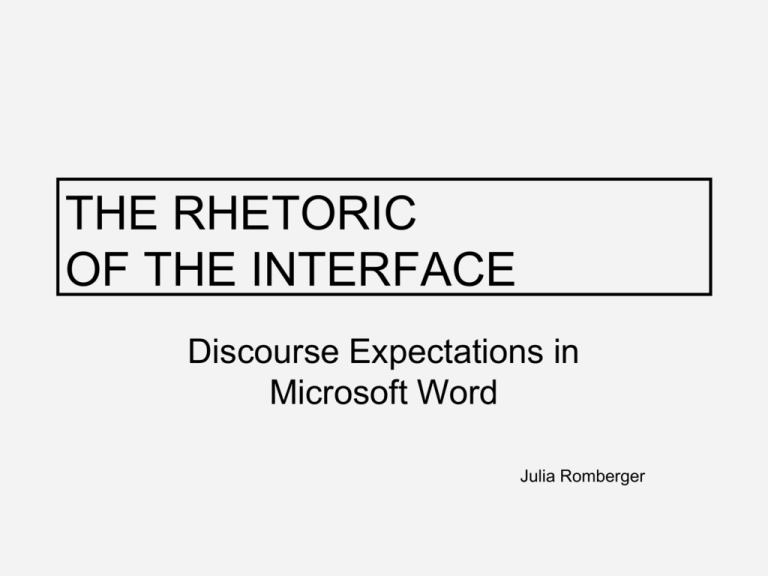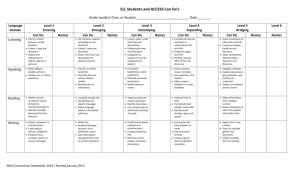Romberger-ppt.
advertisement

THE RHETORIC OF THE INTERFACE Discourse Expectations in Microsoft Word Julia Romberger Overview • • • • Theoretical Basis Useful Concepts for Analysis Types of Iconic Representations Examples of Discourse Communities in MS Word • Implications Andrew Feenberg Technology is the medium of everyday life in modern societies. Every major technological change reverberates at many levels, economic, political, religious, cultural. Insofar as we continue to see the technical and the social as separate domains, important aspects of these dimensions of our existence will remain beyond our reach as a democratic society. The fate of democracy is therefore bound up with our understanding of technology (Questioning Technologies, Preface p. vii) Theoretical Basis for Interrogation of the GUI Modernism & the GUI • “remains true to modernist values of clarity and functionality” - the space of the screen is “ruled by straight lines and rectangular windows” (Manovich, 2001, p. 63). • “reflects larger social logic, ideology, and imaginary of the contemporary society” (Manovich, 2001, p. 118). • master narratives of capitalism and a Tayloristic sense of efficiency is evidenced through features like automation and prearranged templates and wizards, (Lyotard, 1997) Gender & the GUI • early writing software was intended to make “inefficient secretarial (women’s) work” subscribe to an ideal that “appealed to a masculine ideal of machine-like efficiency and limitless energy” that were to be ascribed to the secretary (Pringle, 1989, p 182). • See Grammar and Spell-checkers Concepts for Analysis Multiliteracies “To find our way around this world [of interactive media, desktop publishing, and computer interfaces] requires a new multimodal literacy.” Multiliteracies: Literacy Learning and the Design of Social Futures. Ed. Bill Cope and Mary Kalantzis (2000) Discourse Communities • ”socio-rhetorical network” that “form[s] in order to work towards sets of common goals” (Swales, 1990; Porter, 1992). • presuppose a knowledge base, of both a specific lexis which might be used in specialized and technical ways and of ‘pre-texts’ and genres appropriate to communication within the community (Porter, 1992; Swales, 1990). Rhetoric and the Interface Discourse Community and Subjectivity [P]roduction and consumption of discourse are seen as interpenetrating processes that instead of being directed by the intentions of purpose of the discourse user actually contribute to the user’s own self-understanding and self-definition. (Porter, 1992, p. 195) Types of Iconic Representations Iconic Icons • Denotes its object by virtue of… likeness to or resemblance of that object, on the basis of some quality or characteristic inherent in the icon (Mullet & Sano, 1995, p. 172–173). • These show causality. If the user clicks on this button or selects that menu item, what is shown on the button or represented by the iconographic menu item occurs. Indexical Icons • “[R]efers to its object indirectly, by means of an association … by virtue of its being actually affected or modified by the sign object” (Mullet & Sano, 1995, p. 173). Symbolic Icons • “[D]enotes its object by convention alone, and … depends upon agreement between the parties in communication” (Mullet & Sano, 1995, p. 173). • The symbolic icon relies heavily on foreknowledge on the part of the user who is assumed to have had contact with and extensive use of computers before the encounter. Examples of Discourse Communities in MS Word Microsoft Word’s Lexicon • Drop Cap From Graphic Design Refers to the position of the initial capital letter in a paragraph or on a page. This generally done for aesthetic reasons. • Comment vs. Annotate Comment has undergone a historical shift from annotate. Transition to more common term might be due to Annotate’s linkage with academia. Microsoft Word’s Icons • Clipboard = Paste • Sticky Note = Comment • Paintbrush = Formatting Tool Microsoft Word’s Interactivity • Typewriter Interactivity Microsoft Word’s Interactivity Cont. • Automatic Linking Microsoft Word’s Interactivity Cont. • Changing Automatic Formatting 4 step process Implications Advocate for Industry Change • Documentation for software includes definitions and discussions on what metaphors are used. • Usability testing asks the participants to read interfaces in addition to performing tasks. Rhetorical Interrogation • The myriad discourse communities in electronic media used to compose may create large roadblocks to learning critical technology literacy and critical composition of the electronic media. • The increasing complexity of the interface also impacts attempts to bridge the digital divide. Rhetorical Interrogation cont. • Continuing rhetorical interrogation into assumptions in technology about what constitutes literacy can both empower and raise critical awareness in users in productive ways as they work on their own communications.







